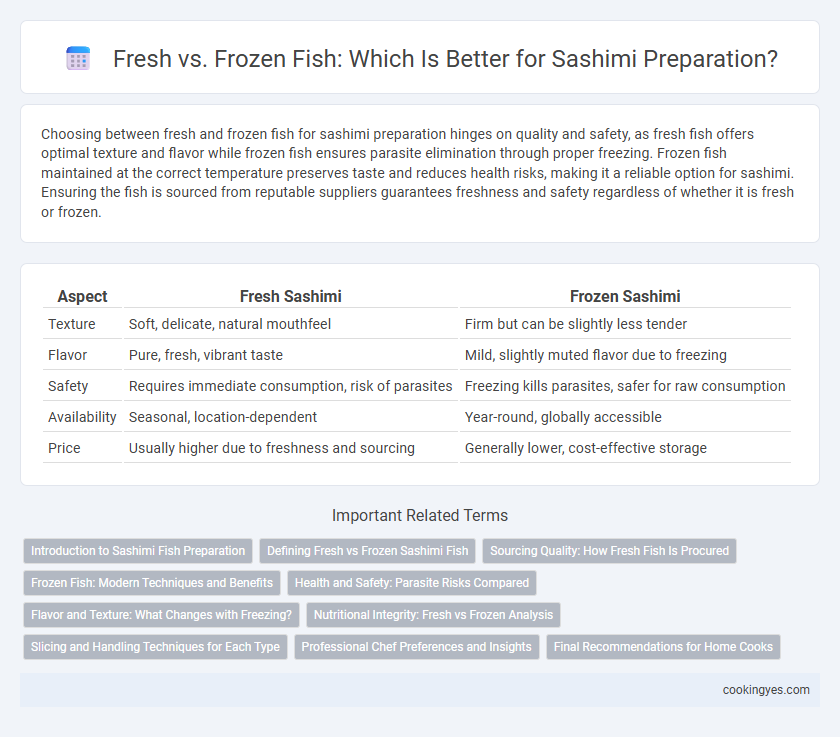Choosing between fresh and frozen fish for sashimi preparation hinges on quality and safety, as fresh fish offers optimal texture and flavor while frozen fish ensures parasite elimination through proper freezing. Frozen fish maintained at the correct temperature preserves taste and reduces health risks, making it a reliable option for sashimi. Ensuring the fish is sourced from reputable suppliers guarantees freshness and safety regardless of whether it is fresh or frozen.
Table of Comparison
| Aspect | Fresh Sashimi | Frozen Sashimi |
|---|---|---|
| Texture | Soft, delicate, natural mouthfeel | Firm but can be slightly less tender |
| Flavor | Pure, fresh, vibrant taste | Mild, slightly muted flavor due to freezing |
| Safety | Requires immediate consumption, risk of parasites | Freezing kills parasites, safer for raw consumption |
| Availability | Seasonal, location-dependent | Year-round, globally accessible |
| Price | Usually higher due to freshness and sourcing | Generally lower, cost-effective storage |
Introduction to Sashimi Fish Preparation
Fresh sashimi-grade fish offers a delicate texture and vibrant flavor essential for authentic sashimi dishes, with immediacy from sea to plate enhancing quality. Frozen fish undergoes strict temperature control, often at -20degC or below for at least seven days, to eliminate parasites and ensure safety without significantly compromising taste. Understanding the balance between freshness and freezing techniques is crucial for optimal sashimi preparation, maintaining both health standards and superior culinary experience.
Defining Fresh vs Frozen Sashimi Fish
Fresh sashimi fish is sourced directly from recently caught seafood, maintaining natural textures and flavors without undergoing freezing processes. Frozen sashimi fish is flash-frozen at extremely low temperatures to eliminate parasites and preserve quality during transport and storage. The key distinction lies in freshness perception versus safety standards, where freezing ensures parasite-free fish but may slightly alter texture compared to strictly fresh sashimi.
Sourcing Quality: How Fresh Fish Is Procured
Sourcing quality for sashimi hinges on selecting fish that meets stringent freshness standards, often procured directly from trusted local fisheries or suppliers specializing in same-day harvests. Fresh fish destined for sashimi is typically handled with rapid chilling and careful storage to maintain optimal texture and flavor, minimizing the risk of bacterial growth. In contrast, frozen fish for sashimi undergoes flash freezing at ultra-low temperatures to preserve freshness, allowing for extended shelf life while retaining safety and taste for high-quality sashimi preparation.
Frozen Fish: Modern Techniques and Benefits
Frozen fish for sashimi undergoes rapid freezing methods such as flash freezing, which preserves the fish's texture, flavor, and nutritional value by preventing ice crystal formation. This technique effectively eliminates parasites, ensuring enhanced safety without compromising taste. Modern cryogenic freezing technologies enable year-round availability of high-quality sashimi-grade fish, supporting consistent supply in sushi restaurants globally.
Health and Safety: Parasite Risks Compared
Fresh sashimi-grade fish must be sourced from reputable suppliers who guarantee immediate consumption to minimize parasite risks, while frozen fish undergoes freezing at -20degC (-4degF) or below for at least seven days to effectively kill parasites, as recommended by food safety authorities. Consuming properly frozen sashimi significantly reduces the likelihood of parasitic infections such as anisakiasis, ensuring higher health and safety standards compared to fresh, unfrozen alternatives. The freezing process preserves the fish's texture and flavor while providing a safer option for raw consumption.
Flavor and Texture: What Changes with Freezing?
Freezing sashimi-grade fish preserves safety by eliminating parasites but can subtly alter flavor and texture due to ice crystal formation, which may cause slight meat fiber damage. Fresh sashimi typically offers a more delicate, buttery texture and pronounced natural flavors, while frozen sashimi may present a firmer bite and slightly muted taste. Proper freezing techniques, such as flash freezing at ultra-low temperatures, minimize these changes, maintaining high quality for sashimi preparation.
Nutritional Integrity: Fresh vs Frozen Analysis
Fresh sashimi fish retains maximum nutritional integrity due to minimal processing and immediate consumption, preserving delicate omega-3 fatty acids and essential vitamins. Frozen sashimi-grade fish, when flash-frozen at ultra-low temperatures, effectively locks in nutrients and minimizes enzymatic degradation, ensuring safety and quality for extended periods. Comparative analyses reveal negligible differences in protein content, while freezing enhances parasite control without substantial nutrient loss, making both options viable for high-quality sashimi preparation.
Slicing and Handling Techniques for Each Type
Fresh sashimi fish requires precise slicing with a sharp, non-serrated knife to maintain texture and flavor, emphasizing clean, swift cuts to prevent tearing. Frozen sashimi fish, often thawed before preparation, demands gentle handling and slightly different slicing angles to preserve firmness and reduce moisture loss. Proper handling techniques vary as fresh fish is more delicate, while frozen fish benefits from controlled thawing and careful sectioning to ensure optimal sashimi quality.
Professional Chef Preferences and Insights
Professional chefs preparing sashimi prioritize ultra-fresh fish for superior texture, flavor, and visual appeal, often preferring catch delivered within hours of harvest. Certain species undergo immediate flash freezing at -60degC or below to eliminate parasites and preserve safety without compromising quality, aligning with strict food safety regulations. Expertise in sourcing and handling dictates the balance between fresh and frozen, with chefs relying on rigorously tested suppliers to ensure optimal sashimi-grade fish.
Final Recommendations for Home Cooks
For home cooks preparing sashimi, using fresh fish from reputable sources ensures optimal texture and flavor, but high-quality frozen fish can be a safe and convenient alternative if properly thawed. Selecting fish labeled as sushi-grade or sashimi-grade guarantees it has been frozen to kill parasites, meeting food safety standards. Always store fish at the right temperature and consume it promptly to maximize freshness and minimize health risks.
Fresh vs Frozen for sashimi fish preparation Infographic

 cookingyes.com
cookingyes.com